Antares, Alpha Scorpii (α Sco) is a red supergiant star located at an approximate distance of 550 light years from Earth in the constellation Scorpius. With an average apparent magnitude of 0.96, it is the brightest star in Scorpius and the 15th brightest star in the sky. It marks the heart of the celestial scorpion and is part of a prominent southern asterism known as the Fish Hook.
Star system
Even though it appears as a single star to the unaided eye, Alpha Scorpii is in fact a binary star system. The system consists of the red supergiant Alpha Scorpii A, formally named Antares, and a fainter blue-white main sequence star designated Alpha Scorpii B. Antares has an apparent magnitude that varies between 0.6 and 1.6, while the companion star is considerably fainter at magnitude 5.5.
The pair’s orbital period is uncertain, with estimates in the range from 880 to 2,562 years. The best calculated orbital period is 1,218 years with a semi-major axis of 2.9’’, but it is not considered to be very reliable.
The separation between the stars was measured at 3.5’’ and 2.5’’ in the 1840s, and more recent measurements have yielded separations between 2.6’’ and 2.8’’. The projected separation between the stars is at least 529 astronomical units (AU). The companion is believed to lie more than 220 AU beyond Antares.
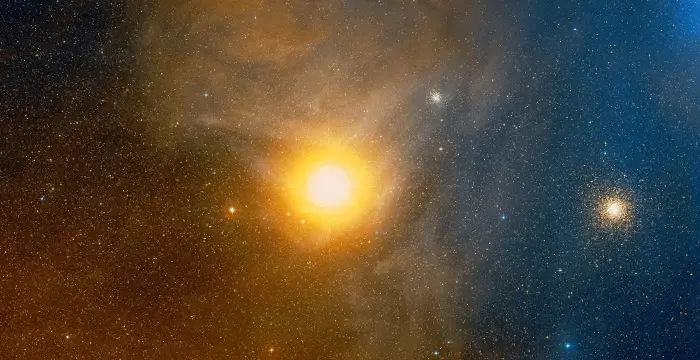
Antares (Alpha Scorpii), image: Wikisky
Alpha Scorpii A
Antares has the stellar classification M1.5Iab-Ib, indicating a supergiant star appearing distinctly red in colour. It has run out of its supply of hydrogen and is currently burning through progressively heavier elements. It has an estimated mass about 12 times that of the Sun. The star’s exact mass is uncertain, but estimates are mostly in the range from 11 to 14.3 solar masses. The supergiant has a projected rotational velocity of 20 km/s. Its estimated age is about 15 million years.
Since evolving away from the main sequence, Antares has expanded to a size of 680 to 800 solar radii. It is losing mass through a powerful stellar wind that has enshrouded the supergiant in an envelope of gas illuminated by the star’s light. The gas cloud is sometimes called the Antares Nebula. Antares has lost about 3 solar masses of material from its initial mass.
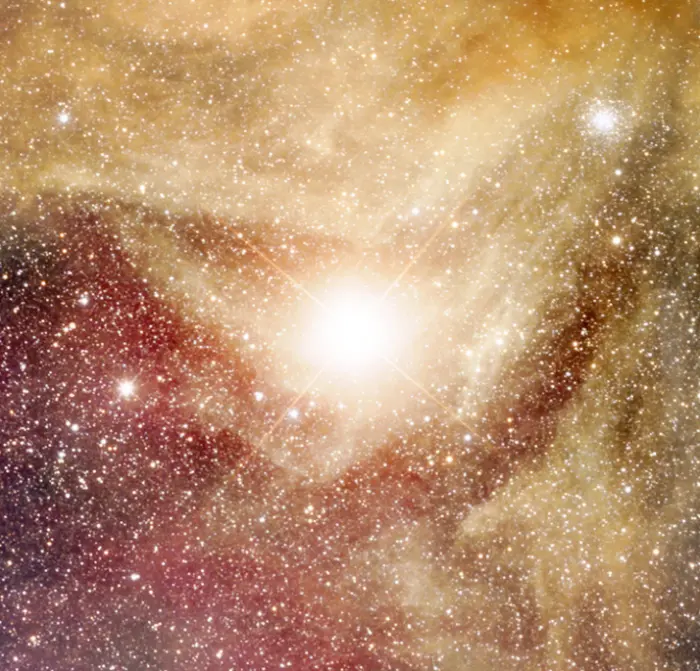
Antares Nebula, image credit: Adam Block/Steward Observatory/University of Arizona (CC BY-SA 3.0)
The supergiant also illuminates parts of the Rho Ophiuchi cloud complex, a star-forming region located approximately 460 light-years away. The star and the complex of interstellar clouds appear in the same wide field of view and are a popular astrophotography target.
With an effective temperature of 3,660 K, Antares is 75,900 times more luminous than the Sun. Like its other properties, the star’s exact luminosity is uncertain, but believed to be in the range from 44,700 to 128,900 solar luminosities. Even though the bolometric luminosity of Antares is about 100,000 times that of the Sun, a lot of the star’s energy output is in the invisible infrared part of the spectrum. At visual wavelengths, Antares is about 10,000 times more luminous than the Sun. Its luminosity is dimmed by interstellar dust, but the degree of dimming is uncertain.
Antares serves as a spectral standard for its class, which means that its spectrum is used as an anchor point for the Morgan-Keenan (MK) system of stellar classification, used to classify other stars.
Antares is classified as a slow irregular variable (type Lc) and its brightness varies from magnitude 0.6 to 1.6. Type Lc variables are supergiant stars of late spectral types whose brightness typically varies by about 1 magnitude. Other stars in this class include the orange supergiants Enif (Epsilon Pegasi), Suhail (Lambda Velorum), NS Puppis, and Omicron1 Canis Majoris, the red bright giants Pi Aurigae, BE Camelopardalis and CQ Camelopardalis, and the red supergiants TZ Cassiopeiae, RX Telescopii and NO Aurigae.
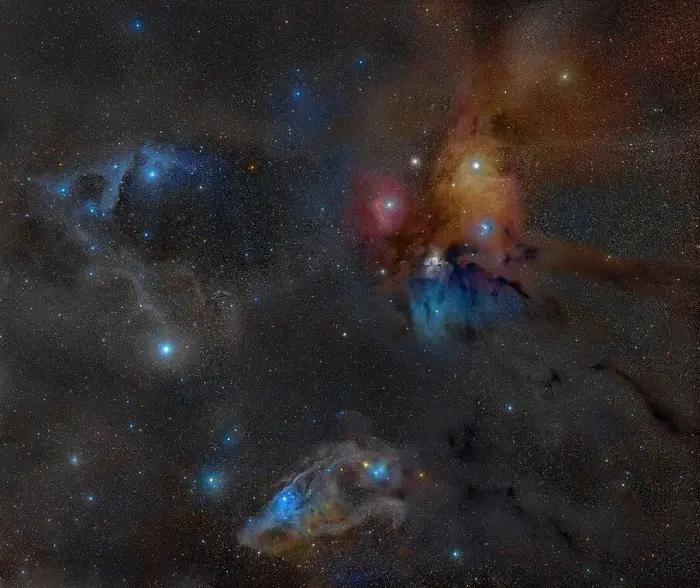
The binary star system Rho Ophiuchi. This star-forming region is located only 400 light years from Earth and is surrounded by a red emission nebula and numerous light and dark brown dust lanes. Nearby is the star Antares while the globular cluster, M4, is visible between Antares and the red emission nebula. Toward the bottom can be found IC 4592, the Blue Horsehead nebula. Note: the stars in this image appear large and white rather than in their true colors due to overexposure, and the image is much more luminous than in reality (with normal computer screen settings). Antares is the white dot in the yellow area. North is towards the bottom. M4 is to the left of Antares, and Sigma Scorpii is to the lower left of M4, in the red area. These three objects form three corners of a pentagon. The other two corners, proceeding counterclockwise, are HD 147889 (near IC 4603) and 22 Scorpii. Far to the left of the pentagon is Pi Scorpii and lower down Dschubba and Acrab, three prominent stars in the head and claws of the scorpion. The multiple star system Rho Ophiuchi itself appears as three white dots in the middle of the blue area just below the pentagon. Image credit: Rogelio Bernal Andreo (CC BY-SA 3.0)
The variability of Antares was reported in 1952 by the South African astronomer Alan William James Cousins, who observed variations in the star’s photographic magnitude in the range from 3.00 to 3.16. The American Association of Variable Star Observers (AAVSO) has monitored the star’s brightness since 1945 and recorded slow variations between magnitudes 0.6 and 1.6. However, the brightness of Antares usually stays near magnitude 1.0.
The star does not have a clear period, but a study published in 2006 that analysed the AAVSO data over the last century suggested a period of 1650 ± 640 days. A 2009 study of long secondary periods in pulsating red giants did not find a separate long secondary period in Antares.
A 2012 study of stars belonging to the Scorpius-Centaurus OB association calculated an initial mass 17.2 times the Sun’s mass and an age of 12 million years (allowing for a margin of error in the range from 11 to 15 million years) for Antares.
In 2013, high spectral resolution imaging of the star’s atmosphere found an outer atmosphere between 1.2 and 1.4 R⋆, an effective temperature of 3,660 ± 120 K, and a mass of 15 ± 5 solar masses, with an estimated age between 11 and 15 million years. Both studies compared the star’s luminosity and temperature to theoretical evolutionary tracks to derive its initial mass. Even if the results vary, Antares is massive enough to end its life as a supernova.
Size
The exact size of Antares is uncertain, but its estimated radius is between 680 and 800 solar radii. If it replaced the Sun in our solar system, it would extend between the orbits of Mars (297-358 R☉) and Jupiter (1,064–1,173 R☉). The star’s physical radius is over three astronomical units (three times the average distance from Earth to the Sun).
The extended outer regions of Antares make it difficult to determine the supergiant’s exact size. Additionally, Antares is a pulsating star and its radius changes by about 19%, or 165 solar radii with the pulsations.
A study published in 1990 yielded an angular diameter of 41.3 ± 0.1 milliarcseconds after observations with the ESO 3.6 m telescope using speckle interferometry during a lunar occultation. More recent measurements of the limb-darkened disk gave diameters of 37.38 ± 0.06 mas in 2009 and 37.31 ± 0.09 mas in 2010. While the star’s physical radius could be derived from its angular size and distance, its exact distance is uncertain, which makes the exact size difficult to pinpoint.
The Hipparcos satellite data gave a parallax of 5.89 ± 1.00 mas for Antares, which translates into a radius about 680 times that of the Sun. Older estimates were higher than 850 solar radii, which made Antares one of the largest known stars at the time.
However, the supergiant is considerably smaller than the former record holder VY Canis Majoris (1,420 solar radii), and it is nowhere near the red supergiants UY Scuti (1,708 R☉) and WOH G64 (1,540 R☉), and the current record-holder for the largest star known, the red hypergiant Stephenson 2-18 (2,150 R☉).
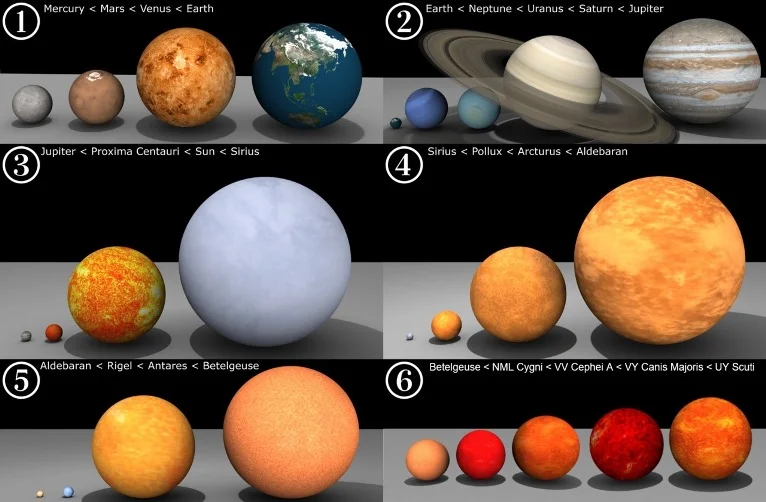
Size comparison of planets and stars, image: Wikimedia Commons/ Dave Jarvis, Jcpag2012, JoeyPknowsalotaboutthat (CC BY-SA 4.0)
Supernova
While the exact mass of Antares is uncertain, the star is most certainly massive enough to be a supernova candidate. Like Betelgeuse in Orion, it may go out as soon as in the next 10 thousand years or at some point in the next million years. When it does, the event could rival the full Moon in brightness and be visible in daytime.
However, the supernova will not affect Earth because Antares is too distant. The event will leave behind either a neutron star or a black hole.
Alpha Scorpii B
Antares B is a bluish main sequence star of the spectral type B2.5V. It has a mass 7.2 times that of the Sun and a radius 5.2 times solar. With a temperature of 18,500 K, it shines with 2,754 solar luminosities. The hot blue star is partly responsible for energizing the nebulosity around Antares.
Alpha Scorpii B is a very fast spinner, with a projected rotational velocity of 250 km/s. It is not massive enough to meet its end as a supernova. Instead, it will end its life as a white dwarf surrounded by a planetary nebula.
Antares B has a visual magnitude of 5.5 but makes a challenging target for small telescopes because of its proximity to the considerably brighter supergiant star. It requires a 6-inch or larger telescope to be seen.
The star can sometimes appear greenish, likely due to the contrast with the orange Antares or to the light of the two stars mixing when they are too close. The spectrum of Alpha Scorpii B shows numerous absorption lines that indicate the presence of matter ejected by the primary component.
Due to its proximity to the bright supergiant, Antares B was not discovered until the 19th century. Austrian astronomer Johann Tobias Bürg discovered it from Vienna during a lunar occultation of the brighter star on April 13, 1819.
In 2021, J. Maíz Apellániz et al. obtained spectral classifications of M1.5 Iab for Antares A and B2 Vn for Antares B. The team obtained spatially resolved spectra for the two components of the Antares system using the lucky spectroscopy technique combined with intermediate-resolution spectroscopy and échelle high-resolution spectroscopy.
Facts
Antares is one of the two stars in the constellation Scorpius selected for use in celestial navigation. The other navigational star in the constellation is Shaula, Lambda Scorpii.
Antares is on average the 15th brightest star in the night sky. It is only slightly fainter than Altair in the constellation Aquila, Acrux in Crux, and Aldebaran in Taurus, and it just outshines the bright Spica in Virgo, Pollux in Gemini, and Fomalhaut in Piscis Austrinus.
Antares is the brightest star in an asterism known as the Fish Hook, which outlines the heart, body, tail, and stinger of the celestial Scorpion. The fishhook pattern is also formed by Alniyat (Sigma Scorpii), Paikauhale (Tau Scorpii), Larawag (Epsilon Scorpii), Xamidimura and Pipirima (Mu1 and Mu2 Scorpii), Zeta Scorpii, Eta Scorpii, Sargas (Theta Scorpii), Iota1 Scorpii, Kappa Scorpii, and Shaula (Lambda Scorpii). It can be used to find many bright deep sky objects that appear in this region of the sky.
Antares is a member of the Upper Scorpius subgroup of the Scorpius-Centaurus Association (Sco OB2), the nearest OB association to the Sun. The members of the Upper Scorpius subgroup have a mean age of 11 million years and lie at an average distance of 550 light years from Earth. Antares is the brightest and most massive star in Sco OB2.
Variations in radial velocity were detected in the star’s spectrum in the early 20th century. Astronomers soon realized that the variations were not the result of the star’s orbital motion but were instead caused by the pulsation of its atmosphere. As early as 1928, calculations pointed to variations in the star’s size by about 20 percent.
The existence of the companion, Antares B, was first reported by the Austrian astronomer Johann Tobias Bürg, who observed Antares during a lunar occultation that occurred on April 13, 1819. However, Bürg’s discovery was dismissed by many who believed it to be merely an atmospheric effect. The companion was then observed several decades later, first by the Scottish astronomer James William Grant from India on July 23, 1844, and then by the American astronomer Ormsby M. Mitchel in 1846. In April 1847, it was measured by the English astronomer William Rutter Dawes.
In 2017, astronomers imaged the surface of Antares using ESO’s Very Large Telescope Interferometer (VLTI). They also mapped the velocities of the material in the star’s atmosphere, revealing unforeseen turmoil. Antares was the first star other than the Sun to be a target of such a study and the image of the star’s surface and atmosphere was the best to date of any star other than the Sun.
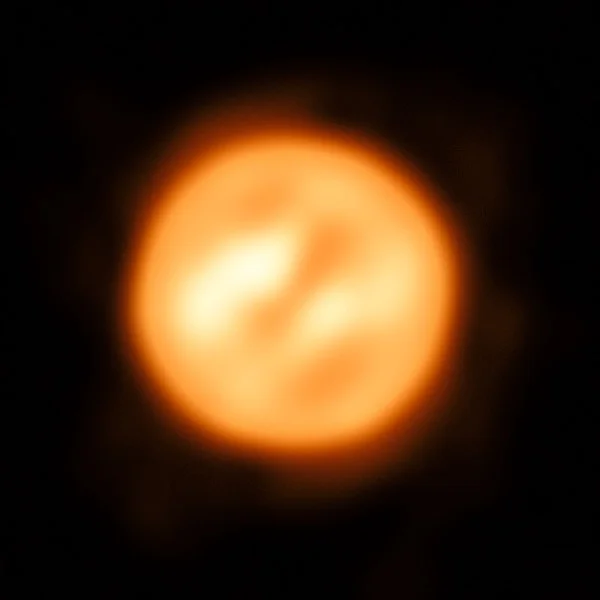
Using ESO’s Very Large Telescope Interferometer astronomers have constructed this remarkable image of the red supergiant star Antares. This is the most detailed image ever of this object, or any other star apart from the Sun. Image: ESO/K. Ohnaka
The aim of the study was to clarify how evolved red supergiants lose their mass so quickly in the late stage of their life. The astronomers concluded that the process could not result from convection (movement of matter that transfers energy from the stellar core to the outer atmosphere) and that a new process was needed to explain the turbulent motion in the star’s extended atmosphere.
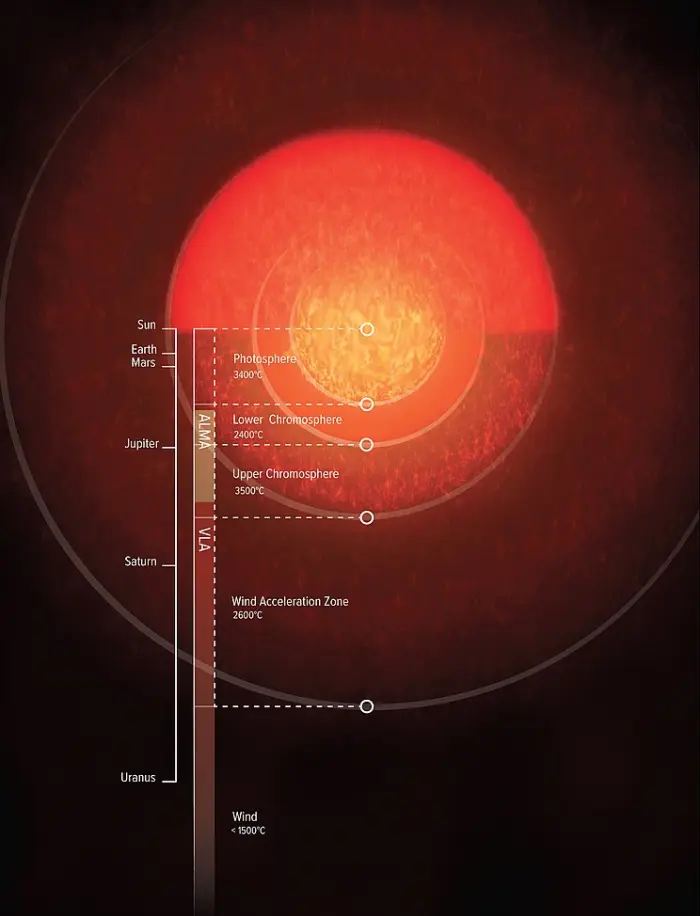
Artist’s impression of the atmosphere of Antares. As seen with the unaided eye (up until the photosphere), Antares is around 700 times larger than our sun, big enough to fill the solar system beyond the orbit of Mars (Solar System scale shown for comparison). But ALMA and VLA showed that its atmosphere, including the lower and upper chromosphere and wind zones, reaches out 12 times farther than that. Image credit: NRAO/AUI/NSF, S. Dagnello (CC BY 3.0)
Antares lies only 4.57 degrees south of the ecliptic (the Sun’s apparent path across the sky) and is frequently occulted by the Moon and sometimes by the planets. It is one of several bright stars in zodiac constellations located within six degrees of the ecliptic. The others are Aldebaran in Taurus, Regulus in Leo and Spica in Virgo. The Sun passes near Antares – about 5 degrees north of the star – in early December every year, and the star is invisible during this period. Antares is occulted by planets only rarely. The last occultation, by Venus, was recorded on September 17, 525 BCE, and the next one will occur on November 17, 2400.
Antares is often compared to Betelgeuse, another exceptionally bright red supergiant. Betelgeuse is similar in colour and brightness. It has the spectral classification M1–M2 Ia–ab and an apparent magnitude that varies from 0.0 to 1.3. The star’s properties are just as challenging to pin down as those of Antares. With an estimated radius between 887 and 955 solar radii, Betelgeuse is somewhat larger than Antares and, at a distance between 640 and 724 light years from Earth, it is also more distant. It is brighter than Antares mainly because of its larger size.
A 2023 study led by Ralph Neuhäuser of the Astrophysical Institute and University Observatory (AIU) Jena in Germany examined pre-telescopic records on the star colour of Antares and Betelgeuse. Neuhäuser and his team were looking for stars that have noticeably evolved in colour in the last millennia.
While Betelgeuse was reported as non-red at the turn of the Common Era, Antares had a constant colour for the last three millennia. The star’s name, which can be interpreted to mean anti-Ares, anti-Mars, rival of Mars or like Mars (“ant Ares”), comes from the 1st millennium BCE and refers to the star’s red colour. The Classical Chinese name, Dahuo, means “Great Fire” and Antares is referred to as a red star (Fire star, Regulator of Fire or the Heart) in the late 2nd or early 1st millennium BC.
Based on the historical records, the study authors concluded that the colour evolution constrains the mass of Betelgeuse to 14 M☉, while the constant colour of Antares indicates that the supergiant is either on the 15 or 16 M☉ track or on the 13 M☉ blue loop.
Antares is one of the brightest stars in near-infrared wavelengths. With a J-band magnitude of -2.7, it outshines R Doradus (-2.6), Arcturus (-2.2) and Aldebaran (-2.1), but is not quite as bright as Betelgeuse (-2.99).
Alpha Scorpii is one of more than 100 known star systems composed of a red supergiant and B-type companion in the Milky Way galaxy. It is the nearest such system to the Sun.
Antares is one of the 27 stars represented on the flag of Brazil. Each star on the flag symbolizes a Brazilian Federative Unit and Antares represents the state of Piauí. Seven other Scorpius stars are featured on the flag: Shaula (Lambda Scorpii), Acrab (Beta Scorpii), Larawag (Epsilon Scorpii), Sargas (Theta Scorpii), Iota Scorpii, Kappa Scorpii, and Mu Scorpii (Xamidimura and Pipirima).
The Ngarrindjeri people of southern Australia associated Antares and its variability with the myth of Waiyungari (“red man”). In local lore, Waiyungari was a young man who was expected to avoid contact with women during his initiation rite. However, his brother Nepeli’s two wives were attracted to him and came to his hut disguised as emus. Waiyungari followed the emus until the women revealed themselves and seduced him. When his brother discovered the betrayal, he set fire to Waiyungari’s hut, where Waiyungari and the women were sleeping. The three were able to escape and, to avoid punishment, Waiyungari threw a spear into the Milky Way and pulled himself and his brother’s wives up into the sky. He became Antares and the women became two fainter stars flanking him. It is said that when the star’s brightness increases, this marks the beginning of initiation rites, when young men must stay away from women. The two fainter stars representing the two women were likely Alniyat (Sigma Scorpii) and Paikauhale (Tau Scorpii).
In medieval astrology, Antares was one of the 15 Behenian fixed stars, believed to be a source of special astrological power. Each of the 15 stars was associated with a planet, a plant and a gemstone, and the latter two would be used in rituals to bring out the star’s influence, e.g. into an amulet. Antares was linked with Venus and Jupiter, and its plant and gemstone were birthwort and sardonyx.
Like many other bright stars, Antares has often been used and referenced in works of fiction. Notable uses in literature include M. A. R. Barker’s Tékumel novels and games, Alfred Bester’s novel The Stars My Destination (1956), Kenneth Bulmer’s Dray Prescot series (1972–1998), Elliot S. Maggin’s novel Superman: Last Son of Krypton (1978), Douglas Adams’ The Restaurant at the End of the Universe (1980), Michael McCollum’s Antares Dawn (1986), and Larry Townsend’s The Scorpius Equation (1993).
Antares is referenced in the graphic novels in the Antares series (2007—2011) by Luiz Eduardo de Oliveira and the Japanese manga series Saint Seiya. The star is also used in a number of computer games, including Frontier: Elite II (1993), Frontier: First Encounters (1995), Master of Orion II: Battle at Antares (1996), Descent: FreeSpace – The Great War (1998), and Star Control II (1992).
Name
The name Antares (pronunciation: /ænˈtɛəriːz/) comes from the Ancient Greek Ἀντάρης, meaning “rivalling Ares.” The name refers to the star’s similarity to the planet Mars due to its reddish appearance. The comparison of the two possibly dates to early Mesopotamian astronomy. Mars is normally considerably fainter than Antares but outshines it for a few months every couple of years. It also passes near the star every two years, which is likely what prompted the comparisons.
The name Antares was officially approved by the International Astronomical Union’s (IAU) Working Group on Star Names (WGSN) on June 30, 2016. It formally applies only to the component Alpha Scorpii A.
Antares has been known by many other names across different cultures. Its ancient Chinese name was 心宿二 (Xīnxiù’èr), or the Second Star of Heart. The Chinese Heart, or Xin (心), mansion is one of the seven mansions of the Azure Dragon and represents the Dragon’s heart. It also contains the stars Alniyat (Sigma Scorpii) and Paikauhale (Tau Scorpii). Antares was the national star of the Shang dynasty (also known as the Yin dynasty), which ruled in the 2nd millennium BCE. Antares was known as 火星 (Huǒxīng), meaning “fiery star.”
In Babylonian astronomy, Antares was known as GABA GIR.TAB, or “the Breast of the Scorpion.” The name was documented in star catalogues dating back to at least 1100 BCE. In the Babylonian astronomy compendium MUL.APIN, compiled around 1000 BCE, the star marks the breast of the goddess Ishara, associated with the underworld and represented by the constellation Scorpius.
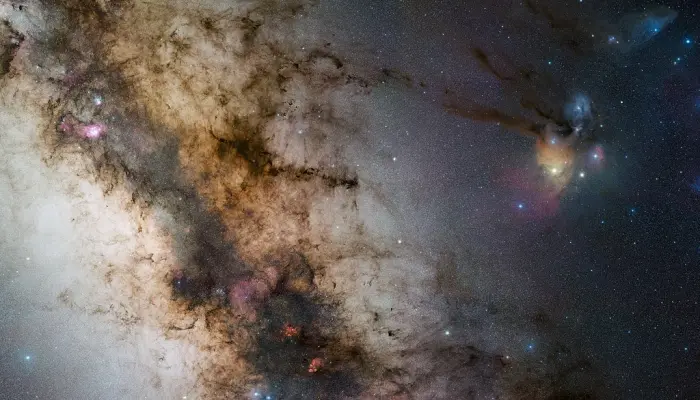
Taken by Stéphane Guisard, an ESO engineer and world-renowned astrophotographer, from Cerro Paranal, home of ESO’s Very Large Telescope, this image directly benefits from the quality of Paranal’s sky, one of the best on the planet. The image shows the region spanning the sky from the constellation of Sagittarius (the Archer) to Scorpius (the Scorpion). The very colourful Rho Ophiuchi and Antares region features prominently to the right, as well as much darker areas, such as the Pipe and Snake Nebulae. The dusty lane of our Milky Way runs obliquely through the image, dotted with remarkable bright, reddish nebulae, such as the Lagoon and the Trifid Nebulae, as well as NGC 6357 and NGC 6334. This dark lane also hosts the very center of our Galaxy, where a supermassive black hole is lurking. The image was obtained by observing with a 10-cm Takahashi FSQ106Ed f/3.6 telescope and a SBIG STL CCD camera, using a NJP160 mount. Images were collected through three different filters (B, V and R) and then stitched together. This mosaic was assembled from 52 different sky fields made from about 1200 individual images totalling 200 hours exposure time, with the final image having a size of 24 403 x 13 973 pixels. Image credit: ESO/S. Guisard (CC BY 4.0)
In ancient Greece, Antares was called Καρδία Σκορπίου (Kardia Skorpiū), meaning “the heart of the scorpion.” The name was translated into Arabic as Calbalakrab, derived from the phrase Qalb al-Άqrab. The Latin equivalent of the name was Cor Scorpii.
In Mesopotamian astronomy, Antares was known by several names, including Kakkab Bir (“the Vermilion Star”), Kak-shisa (“the Creator of Prosperity”), Masu Sar (“the Hero and the King”), and Dar Lugal (“The King”).
In ancient Egypt, the star was called tms n hntt, meaning “the red one of the prow.” It was associated with Serket, the goddess of fertility and healing.
Antares was one of the four Royal Stars of Persia, along with Aldebaran, Regulus and Fomalhaut. The four stars were seen as guardians of the four districts of the sky and commonly used for navigation. Antares was known as Satevis, the watcher of the west.
The Māori people of New Zealand know the star as Rēhua, a sacred figure who lives in the highest of heavens, is immortal and has the power to heal any illness. Another Māori name for Antares is Rerehu, meaning “burning.” The Wotjobaluk people of the state of Victoria in Australia associated Antares with Djuit, son of Marpean-kurrk, a female ancestral figure represented by Arcturus. The Kulin Kooris knew Antares as Balayang, brother of Bunjil, represented by Altair.
In Hawaii, Antares is known as Hoku-ula, meaning “red star,” or Mehakua-koko, where “koko” means “red.” The former name was also used for Betelgeuse in the Hawaiian Islands. Another Hawaiian name for Antares is Lehua Kona.
In Hawaiian legend, the constellation of Scorpius is associated with Maui’s fishhook (Manaiakalani). Māui was a mythical chief who used the fishhook to pull out the Hawaiian Islands from the bottom of the ocean. Antares appears directly above the point of the hook.
In the Tuamotan language in Polynesia, Antares is called Te Mata-heko, “red star.”
The Bedouin knew the star as al-Qalb, “the heart.”
Location
Antares is very easy to find because it is one of the brightest stars in the sky and part of a prominent asterism, the Fish Hook of Scorpius. The star and the asterism appear near the bright band of the Milky Way galaxy.
Marking the Scorpion’s heart, Antares lies near the centre of Scorpius constellation and is flanked by two relatively bright stars, the magnitude 2.88 Alniyat (Sigma Scorpii) and magnitude 2.82 Paikauhale (Tau Scorpii). The two stars mark the arteries near the heart of the scorpion. Antares is the brightest star near the scorpion’s claws, formed by Acrab (Beta1 Scorpii), Dschubba (Delta Scorpii), and Fang (Pi Scorpii). The bright stars that form the Teapot in Sagittarius can be used for orientation.
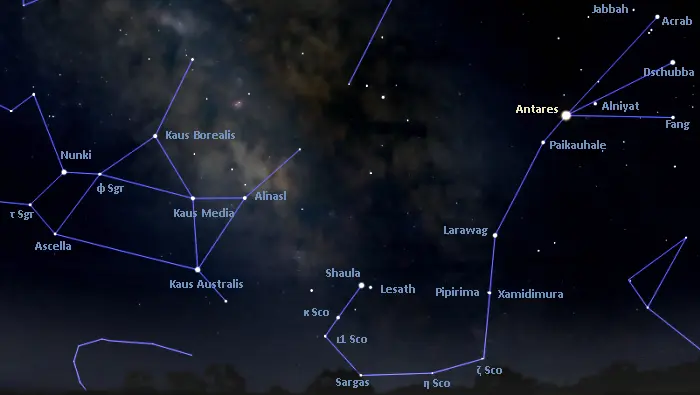
The location of Antares, image: Stellarium
Antares is located in the southern sky and can be seen from all locations south of the latitude 63° N, for at least part of the year. The star is circumpolar, i.e. it never sets and is visible year-round, from most of the southern hemisphere.
Northern observers can see it above the southern horizon in the summer months, while observers south of the equator can see it much higher in the sky for most of the year. From the northern hemisphere, the star always appears in the southern sky.
Antares reaches its highest point in the sky at dawn in early March and at sundown in early September. Its midnight culmination is around May 31 or June 1, when it is at opposition to the Sun and stays visible throughout the night. The star is invisible for several weeks around November 30 because it is too close to the Sun.
Antares can be used to find several interesting deep sky objects that lie in the vicinity. The brightest of these, the globular cluster Messier 4, appears only 1.3 degrees west of the star. The cluster appears quite large, occupying an area of 26′, and has an apparent magnitude of 5.9. It stretches over an area 75 light years across and its stars can be resolved in medium-sized telescopes. The cluster lies at a distance of 7,200 light years and has an estimated age of 12.2 billion years. It is one of the nearest globular clusters to the Sun.
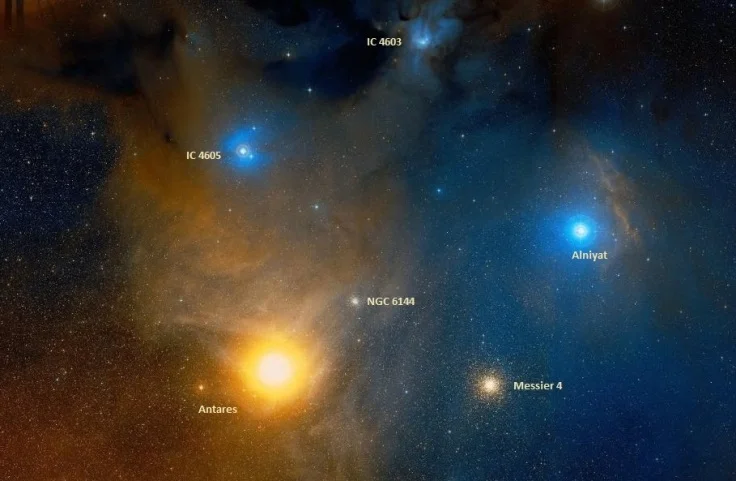
Antares, Messier 4, NGC 6144, IC 4605 and IC 4603, image: Wikisky
The smaller and fainter globular cluster NGC 6144 appears closer to Antares. It has an apparent magnitude of 9.63 and an apparent size of 1′.8.
The reflection nebulae IC 4605 around the star 22 Scorpii and IC 4603 around SAO 184376 appear in the same region, in the neighbouring constellation Ophiuchus. They are part of the Rho Ophiuchi cloud complex, one of the nearest stellar nurseries to the Sun.
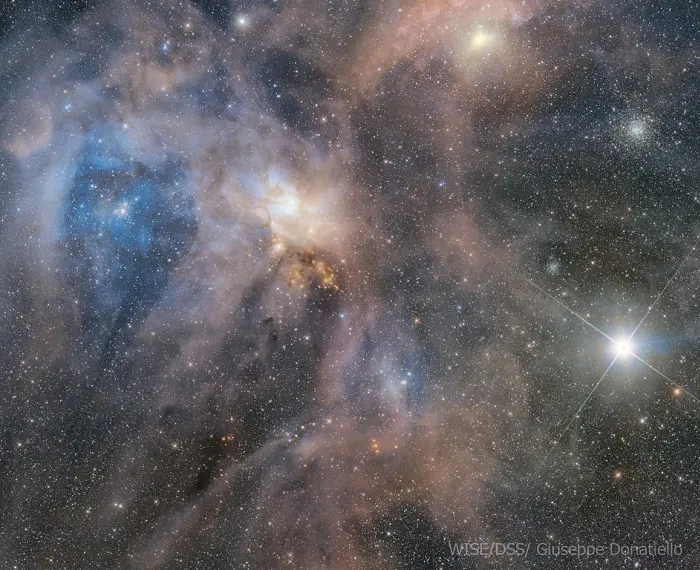
The Rho Ophiuchi cloud complex is a dark nebula of gas and dust that is located 1° south of the star ρ Ophiuchi. At an estimated distance of 131 ± 3 parsecs, this cloud is one of the closest star-forming regions to the Solar System. This cloud covers an angular area of 4.5° × 6.5° in the Sky. The brightest star in this image is Antares (Alpha Scorpii or α Sco), the fifteenth brightest star in the sky and the brightest star in the constellation Scorpius. Image credit: WISE/DSS/ Giuseppe Donatiello (CC0 1.0)
The globular cluster Messier 80 can be found roughly halfway between Antares and Acrab in the Scorpion’s claws. It has an apparent magnitude of 7.2 and an apparent size of 10 arcminutes.
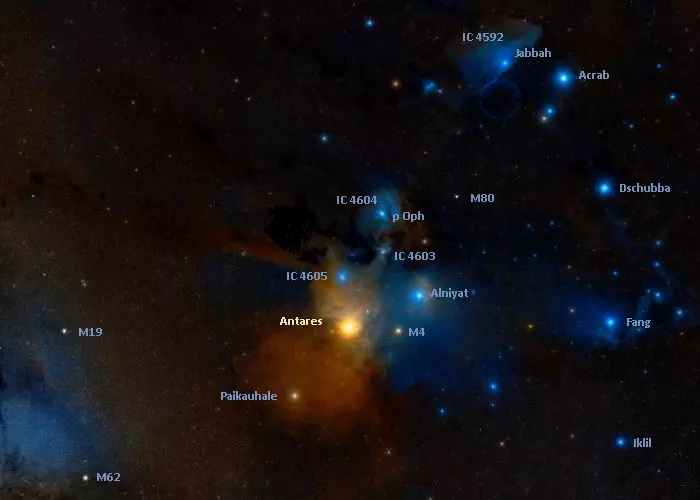
Deep sky objects near Antares, image: Wikisky
Antares can also be used to find two globular clusters in Ophiuchus. Messier 19 lies on the imaginary line drawn from Fang in the Scorpion’s claws through Antares and extended by about the same distance as that between the two stars. Messier 62 lies 7.5 degrees southeast of Antares, about a third of the way from the supergiant to Kaus Australis, the brightest star in the neighbouring Sagittarius.
Constellation
Antares is located in the southern constellation Scorpius. Like other constellations in the zodiac family, Scorpius is one of the Greek constellations, first listed by the Greco-Roman astronomer Ptolemy of Alexandria in the 2nd century CE. It represents the scorpion that stung Orion, the Hunter, in Greek mythology. It is said that Orion and the scorpion were placed at the opposite ends of the sky and the two constellations never appear above the horizon at the same time because Orion is still fleeing from the scorpion.
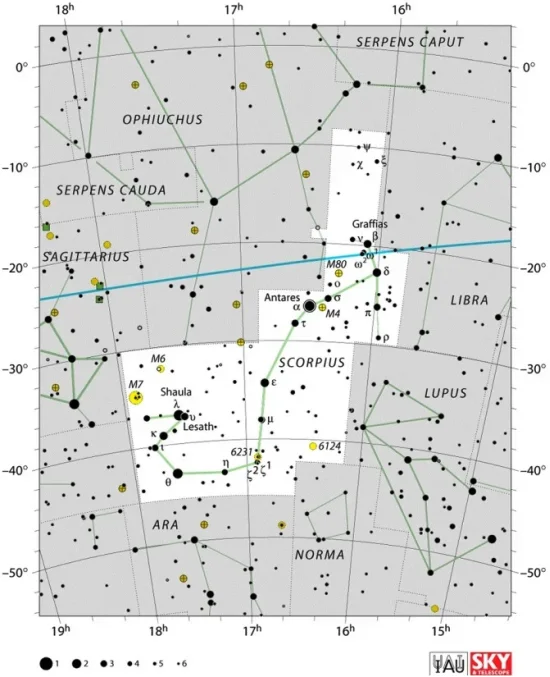
Scorpius constellation map by IAU and Sky&Telescope magazine
Scorpius is located in a rich field of the Milky Way and can be seen in its entirety from locations between the latitudes 40° N and 90° S. Observers in the mid-northern latitudes can see the constellation above the southern horizon during the summer months. Scorpius is easy to recognize because it lies to the right of the Teapot in Sagittarius, straddling the Milky Way, with its brightest stars forming the outline of the Scorpion’s claws, body and tail with a stinger.
Scorpius is known for its bright stars Antares and Shaula, as well as for its many bright deep sky objects. In addition to those already mentioned, these include the open clusters NGC 6821, the Northern Jewel Box Cluster (NGC 6231), Ptolemy’s Cluster (Messier 7), and the Butterfly Cluster (Messier 6), the emission nebula NGC 6334, nicknamed the Cat’s Paw Nebula, the diffuse nebula NGC 6357, known as the Lobster Nebula or War and Peace Nebula, and the bipolar planetary nebula NGC 6302, also known as the Butterfly or Bug Nebula.
The best time of the year to observe the stars and deep sky objects of Scorpius is during the month of July, when the constellation is prominent in the southern sky in the evening.
The 10 brightest stars in Scorpius are Antares (Alpha Sco A, mag. 0.6 – 1.6), Shaula (Lambda Sco A, mag. 1.62), Sargas (Theta Sco A, mag. 1.84), Dschubba (Delta Sco, mag 2.307), Larawag (Epsilon Sco, mag. 2.31), Kappa Sco (mag. 2.39), Acrab (Beta Sco, mag. 2.62), Lesath (Upsilon Sco, mag. 2.70), Paikauhale (Tau Sco, mag. 2.82), and Fang (Pi Sco, mag. 2.89).
Antares – Alpha Scorpii
| Spectral class | M1.5Iab-Ib (Antares A), B2.5V (Antares B) |
| Variable type | Slow irregular variable (Lc) |
| U-B colour index | +1.34 |
| B-V colour index | +1.83 |
| Apparent magnitude | 0.6 – 1.6 (Antares A), 5.5 (Antares B) |
| Absolute magnitude | -5.28 (variable) |
| Distance (approx.) | 550 light years (170 parsecs) |
| Parallax | 5.89 ± 1.00 mas |
| Radial velocity | -3.4 km/s |
| Proper motion | RA: -12.11 mas/yr |
| Dec.: -23.30 mas/yr | |
| Constellation | Scorpius |
| Right ascension | 16h 29m 24.45970s |
| Declination | −26° 25′ 55.2094″ |
| Designations | Antares, Alpha Scorpii, α Sco, 21 Scorpii, HR 6134, HIP 80763, FK5 616, SAO 184415, CD−26°11359, CCDM J16294-2626, WDS 16294-2626, IRAS 16262-2619, ADS 10074 AB, GC 22157, GCRV 9479, PPM 265579, LBN 1108, LBN 351.88+15.11, 2MASS J16292443-2625549 |
Alpha Scorpii A
| Spectral class | M1.5Iab-Ib |
| Apparent magnitude | 0.6 – 1.6 |
| Mass | 11 – 14.3 M☉ |
| Luminosity | 75,900 L☉ (44,700 – 128,900 L☉) |
| Radius | 680–800 R☉ |
| Temperature | 3,660 ± 120 K |
| Age | 15 ± 5 million years |
| Rotational velocity | 20 km/s |
| Surface gravity | −0.1 to −0.2 cgs |
| Designations | Antares, Alpha Scorpii A, α Sco A, HD 148478, AAVSO 1623-26, TYC 6803-2158-1 |
Alpha Scorpii B
| Spectral class | B2.5V |
| Apparent magnitude | 5.5 |
| Mass | 7.2 M☉ |
| Luminosity | 2,754 L☉ |
| Radius | 5.2 R☉ |
| Temperature | 18,500 K |
| Rotational velocity | 250 km/s |
| Surface gravity | 3.9 cgs |
| Designations | Alpha Scorpii B, α Sco B, HD 148479, GCRV 9480 |